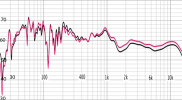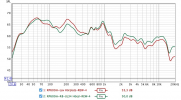As others already mentioned, when taking an image capture snapshot in REW, try to set a 50 dB vertical scale limit to make your graphs more visually comparable. A +- 10 dB leeway is fine, too. And if you want even more consistency regardless of the vertical scale limit, you could also use a fixed 25 dB/decade graph aspect ratio -- although, I often skip that step in order to save space.
I think it's obvious that these speakers will require EQ even with the horn waveguide. Realistically, there will still be an effect coming from the room, but much, much less so... Below the transition zone, the room dominates so we can't really criticize him about it too much. C'mon... I'm sure we've seen worse rooms and MLP measurements than this.
Incidentally, I'd be curious to see some frequency dependent windowing (say, 5-7 cycles) applied to see what the "direct sound" is like when the the rest of the later arriving, reflected energy is filtered out. Some speakers' frequency response magnitude trace, when placed well beyond the critical distance in an untreated room, appear to utterly "collapse" when FDW is applied -- almost seems like the speakers are broken -- but, no, they're usually not.
Still, one can get a good enough sound, of course... but there will be lots of added "room sound" ambience/coloration. Equalization through speaker amps and uncontrolled room reverb is not what I would call desirable if fidelity to the source were a top priority.



